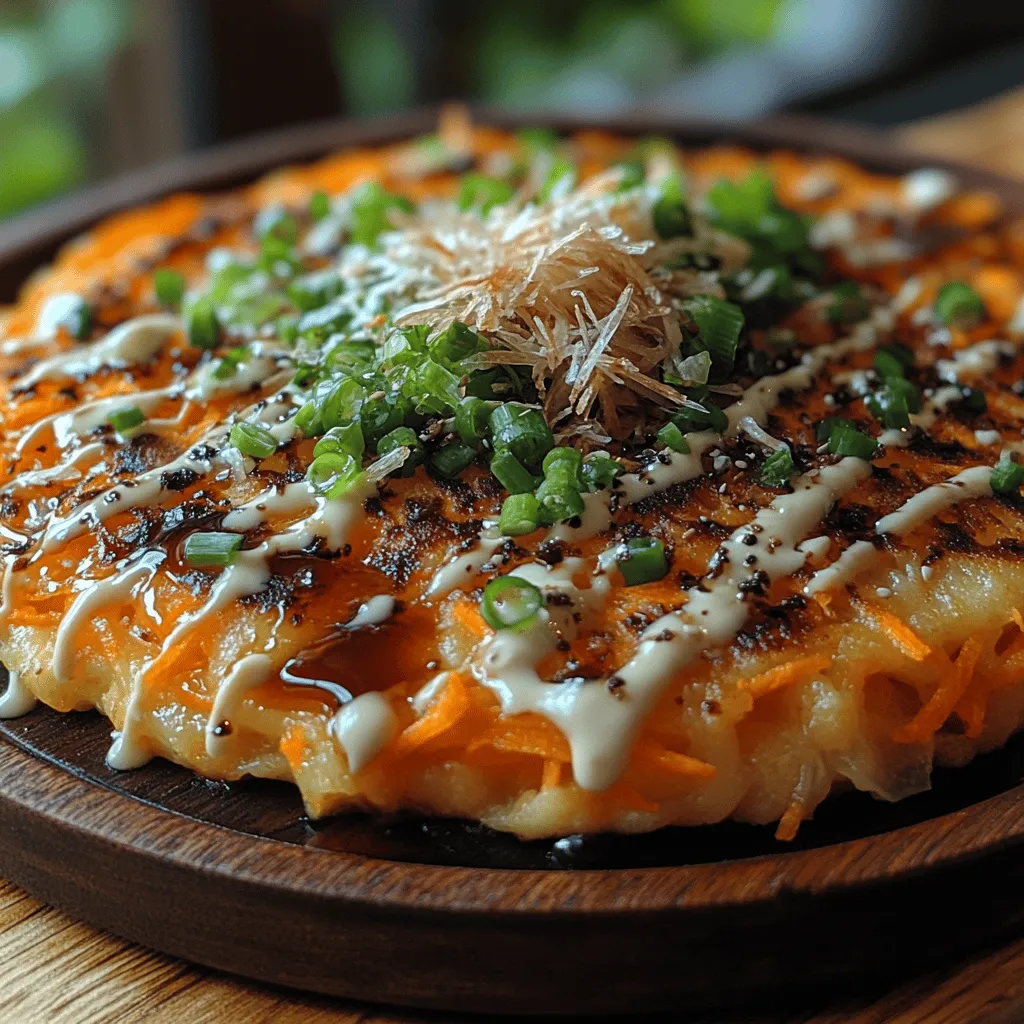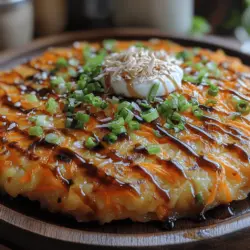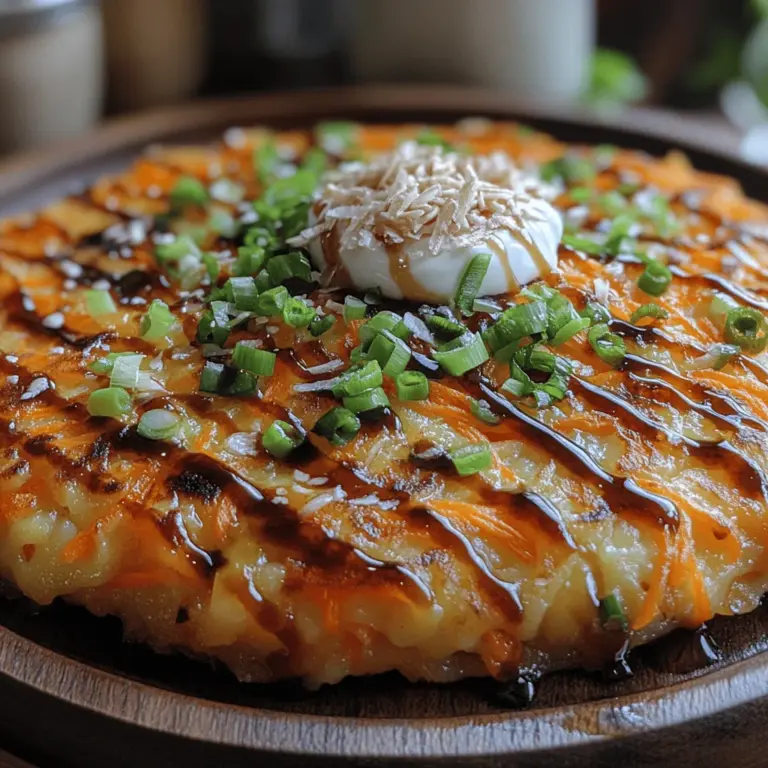Introduction
Okonomiyaki, a savory Japanese pancake, has captured the hearts and taste buds of food lovers around the world. Originating from Osaka, Okonomiyaki translates to “grilled as you like it,” reflecting its flexible nature and the ability to customize ingredients based on personal preferences. Traditionally, this dish combines a rich batter with various fillings, ranging from meats and seafood to vegetables, making it a beloved comfort food in Japan.
Today, we introduce you to a delightful twist on this classic dish: Carrot Okonomiyaki Delight. This innovative version not only maintains the essence of the original but also incorporates the vibrant flavor and health benefits of carrots. As we navigate through the recipe, you’ll discover how this dish is not only delicious but also versatile, suitable for various dietary preferences, including vegetarian and gluten-free options.
Beyond being simply a tasty dish, carrots provide an array of health benefits. Rich in vitamins, particularly vitamin A, carrots are known for supporting eye health, boosting the immune system, and contributing to overall well-being. When combined with other fresh ingredients like green onions and cabbage, Carrot Okonomiyaki Delight becomes a nutritious meal that doesn’t compromise on flavor.
Understanding Okonomiyaki
Okonomiyaki is more than just a dish; it’s a cultural experience steeped in Japanese tradition. Commonly enjoyed during gatherings and festivals, this savory pancake is made using a batter of flour, eggs, water, and shredded cabbage, with various fillings added according to one’s taste. The dish is then cooked on a hot griddle, often right at the dining table, making it a fun and interactive meal.
Historically, Okonomiyaki can be traced back to the Edo period when it began as a simple flour and water mixture, evolving over time to include a variety of ingredients. The two most famous regional variations are Hiroshima-style, which layers ingredients rather than mixing them, and Osaka-style, which is the version most commonly associated with the dish. Regardless of the style, Okonomiyaki remains a staple in Japanese cuisine, embodying the concept of “yōshoku” or Western-influenced dishes.
While the traditional Okonomiyaki features a medley of ingredients, the Carrot Okonomiyaki Delight takes a refreshing approach. By focusing on the sweet and earthy flavors of carrots, this recipe caters to those looking for a lighter yet satisfying meal.
The Appeal of Carrot Okonomiyaki Delight
One of the standout features of Carrot Okonomiyaki Delight is its unique flavor profile. The sweetness of the carrots complements the savory elements of the batter, creating a harmonious balance between taste and texture. With each bite, you’ll experience the crunchiness of fresh vegetables combined with the fluffiness of the pancake, making it a delightful culinary experience.
Incorporating carrots into the recipe not only enhances its nutritional value but also adds a vibrant color that makes the dish visually appealing. The bright orange of the carrots stands out against the green of the onions and the pale yellow of the batter, creating a feast for the eyes as well as the palate.
When comparing Carrot Okonomiyaki with traditional versions, you’ll find that this twist offers a lighter alternative without sacrificing the essence of what makes Okonomiyaki so special. Furthermore, the versatility of the dish allows for easy modifications, making it suitable for various dietary needs. For instance, those following a gluten-free diet can substitute standard flour with gluten-free alternatives, while vegans can replace eggs with flaxseed meal mixed with water for binding.
Ingredient Breakdown
To create the Carrot Okonomiyaki Delight, it’s essential to understand the role of each ingredient in contributing to the final dish. Let’s explore the key components:
Carrots
Carrots are the star of this recipe, providing not only a natural sweetness but also a wealth of nutrients. Rich in beta-carotene, carrots are known for their antioxidant properties and are vital for maintaining healthy vision. They add moisture to the batter, preventing the pancake from becoming dry, while also giving it a vibrant color.
All-Purpose Flour
All-purpose flour serves as the foundation for the Okonomiyaki batter. It provides structure and helps bind the ingredients together. The type of flour you choose can influence the texture of the pancake—using a lighter flour will yield a fluffier pancake, while a denser flour can result in a heartier bite.
Water vs. Dashi Stock
Water is a common liquid used to create the batter, but for a more authentic flavor, dashi stock can be used. Dashi is a traditional Japanese stock made from kombu (seaweed) and bonito flakes (dried fish), imparting a rich umami flavor to the dish. If you prefer a vegetarian option, you can find vegan dashi or use a simple vegetable broth as a substitute.
Eggs
Eggs are crucial in this recipe, providing binding properties that hold the pancake together while adding richness. They also contribute to the light and fluffy texture that makes Okonomiyaki so enjoyable. For a vegan alternative, consider using a flaxseed or chia seed “egg” to achieve similar binding results.
Green Onions and Cabbage
Green onions and cabbage are essential vegetables in Okonomiyaki, enhancing both flavor and texture. Green onions add a sharp, fresh note, while cabbage provides a satisfying crunch. These vegetables are not only tasty but also packed with vitamins and fiber, making your dish more nutritious.
Soy Sauce and Sesame Oil
Soy sauce and sesame oil are indispensable when it comes to flavoring Okonomiyaki. Soy sauce adds depth and saltiness, while sesame oil infuses a nutty aroma that elevates the overall taste. These ingredients contribute to the umami profile that is characteristic of Japanese cuisine.
Seasoning
A simple blend of salt and pepper is often enough to enhance the flavors of your Carrot Okonomiyaki Delight. However, feel free to experiment with additional seasonings such as garlic powder, or even a dash of chili flakes for those who prefer a bit of heat.
Toppings
Toppings play a significant role in the final presentation and flavor of Okonomiyaki. The classic Okonomiyaki sauce—a tangy, sweet sauce similar to Worcestershire sauce—adds a rich flavor that complements the pancake perfectly. Kewpie mayonnaise, a Japanese-style mayonnaise, brings creaminess and additional flavor. Finally, bonito flakes and aonori (seaweed flakes) offer a savory finish that enhances the dish’s authenticity.
Step-by-Step Cooking Instructions
Now that we have covered the ingredients, let’s dive into the preparation process for your Carrot Okonomiyaki Delight. The following steps will guide you through preparing the vegetables, ensuring you achieve the perfect balance of flavors and textures.
1. Prepare the Carrots: Start by washing and peeling the carrots. Once peeled, grate them using a box grater or food processor. Aim for fine shreds to ensure they cook evenly and integrate well into the batter.
2. Chop the Cabbage and Green Onions: Next, finely chop the cabbage and green onions. The cabbage should be shredded into thin strips, while the green onions can be sliced into thin rounds. Set them aside as you prepare the batter.
3. Mix the Dry Ingredients: In a large mixing bowl, combine the all-purpose flour, salt, and pepper. Mix well to ensure the salt and pepper are evenly distributed throughout the flour.
4. Combine the Wet Ingredients: In a separate bowl, whisk together the eggs and water (or dashi stock). If using dashi, ensure it’s at room temperature to maintain the batter consistency. Gradually add this mixture to the dry ingredients, stirring until you achieve a smooth batter.
5. Incorporate the Vegetables: Fold in the grated carrots, chopped cabbage, and green onions into the batter. Mix gently until the vegetables are evenly coated with the batter. Be careful not to overmix, as this can affect the texture of the pancake.
6. Prepare to Cook: Heat a non-stick skillet or griddle over medium heat and lightly grease it with oil. Once the skillet is hot, ladle a portion of the batter onto the skillet, shaping it into a round pancake approximately 6–8 inches in diameter.
As you follow these steps, you’ll begin to see the transformation of simple ingredients into a delicious and visually appealing dish. The Carrot Okonomiyaki Delight is not just a meal; it’s an experience that brings together the rich flavors of Japan with a healthy twist. Stay tuned for further instructions on cooking, serving, and enjoying this delightful recipe.

Techniques for Grating Carrots and Slicing Cabbage
To prepare your Carrot Okonomiyaki Delight, it’s essential to start with properly prepared vegetables. Grating carrots and slicing cabbage are two fundamental techniques that can significantly influence the texture and flavor of the dish.
Grating Carrots: Use a box grater or a food processor to achieve fine or medium shreds. If you prefer a more rustic texture, you can also use a knife to julienne the carrots. Regardless of the method, ensure that the carrot shreds are uniform in size to allow for even cooking. If you choose to use a food processor, be cautious not to over-process, as this can lead to a mushy texture.
Slicing Cabbage: For cabbage, a sharp knife or a mandoline slicer is your best friend. Cut the cabbage into quarters, remove the core, and then slice thinly. Aim for ribbons that are about 1/4 inch wide. Uniform slices will help the cabbage cook evenly and integrate well with the batter.
Importance of Uniform Vegetable Sizes for Even Cooking
When making okonomiyaki, uniform vegetable sizes are crucial. This ensures that every bite has a balanced flavor and texture. If some pieces are larger or smaller than others, they will cook at different rates, leading to unevenly cooked okonomiyaki. For the best results, take your time during the prep phase to ensure that all your vegetables are cut to similar sizes.
Making the Batter
The batter is the heart of any okonomiyaki, and getting it right is key to a successful dish.
Tips on Achieving the Right Consistency for the Batter: The batter should have a thick, pancake-like consistency. You can achieve this by combining all-purpose flour with water, dashi stock, or even vegetable broth, depending on your preference. Start with a 1:1 ratio of flour to liquid, then adjust as needed. If the batter is too thick, it won’t spread well in the pan; if it’s too thin, the okonomiyaki will fall apart.
Discussion on Whisking Techniques to Avoid Lumps: When mixing the batter, use a whisk to blend the flour and liquid thoroughly. Begin by whisking slowly to combine the ingredients, then increase your speed to eliminate lumps. A smooth batter is essential for a light and fluffy texture. If lumps persist, you can pass the batter through a fine mesh sieve to remove them.
Adding the Vegetables
Incorporating your vegetables into the batter is the next step, and it’s important to do this correctly.
Importance of Folding Instead of Stirring: When adding the grated carrots and sliced cabbage to the batter, use a folding technique rather than stirring. This gentle method helps to incorporate the vegetables without deflating the batter, ensuring a light and airy okonomiyaki.
Ensuring Even Distribution of Flavors: As you fold, take care to evenly distribute the vegetables throughout the batter. This not only enhances the flavor but also ensures that every piece of okonomiyaki has a delightful mix of textures.
Cooking the Okonomiyaki
Cooking your okonomiyaki correctly is vital to achieving the perfect texture and flavor.
Optimal Frying Techniques for Perfect Texture: Heat a non-stick skillet or griddle over medium heat and add a small amount of oil. Once the oil is hot, pour a ladleful of the batter-vegetable mixture into the skillet, spreading it gently into a round shape. Cook for about 4-5 minutes or until the bottom is golden brown before flipping.
Tips for Flipping Without Breaking: Flipping the okonomiyaki can be tricky. Use a large spatula or two spatulas to carefully lift and turn it over in one smooth motion. If you find it difficult to flip, you can cut the okonomiyaki in half to make it easier to manage. Ensure the second side cooks for an additional 4-5 minutes until it is cooked through and golden.
Dressing and Serving
Presentation plays a significant role in the enjoyment of your Carrot Okonomiyaki Delight.
Creative Ways to Drizzle Sauces for Best Presentation: Traditional toppings include okonomiyaki sauce, mayonnaise, and bonito flakes. To create an appealing presentation, use a squeeze bottle to drizzle sauces in a zig-zag pattern over the top. Finish with a sprinkle of chopped green onions or seaweed flakes for added color and flavor.
Suggestions for Serving and Garnishing: Serve your okonomiyaki hot from the skillet, cut into wedges. Accompany it with a simple salad or pickled vegetables for a refreshing contrast. For garnish, you can add sesame seeds, a sprinkle of shichimi togarashi, or a dash of chili sauce for those who enjoy a little heat.
Nutritional Information
It’s important to consider the nutritional benefits of the ingredients used in your Carrot Okonomiyaki Delight.
Overview of the Nutritional Values Per Serving: A standard serving of okonomiyaki typically contains approximately 200-300 calories, depending on the toppings and portion size. It provides a good source of carbohydrates, fiber, and vitamins, particularly from the carrots and cabbage.
Discussion on the Health Benefits of Key Ingredients: Carrots are rich in beta-carotene, fiber, and antioxidants, while cabbage offers vitamin K, vitamin C, and a variety of phytonutrients. Together, these ingredients help promote healthy digestion, support eye health, and boost immunity.
Potential Dietary Adjustments: For those with dietary restrictions, this recipe can easily be modified. You can use gluten-free flour to make the batter suitable for gluten-sensitive individuals. Additionally, for a vegetarian version, ensure that your dashi stock is vegetable-based.
Serving Suggestions
Pairing your Carrot Okonomiyaki Delight with complementary dishes can elevate the meal experience.
Ideal Side Dishes and Drinks: Serve your okonomiyaki with a side of miso soup or a fresh cucumber salad for a balanced meal. For drinks, consider pairing it with green tea or a light Japanese beer to enhance the flavors.
Suggestions for Customizing Toppings Based on Personal Preference: Feel free to customize your okonomiyaki with additional toppings such as sliced mushrooms, shredded cheese, or even cooked shrimp for a heartier version. The beauty of okonomiyaki lies in its versatility, allowing you to experiment with various flavors.
How to Make It a Full Meal: To transform your okonomiyaki into a complete meal, consider adding protein such as tofu or grilled chicken into the batter. Alternatively, serve it alongside steamed rice and a protein of your choice to round out the dining experience.
Conclusion
Carrot Okonomiyaki Delight stands out as a fun, nutritious, and versatile dish that brings the flavors of Japanese cuisine to your kitchen. With its vibrant colors and unique textures, this recipe is perfect for family gatherings, casual dinners, or even meal prep for the week ahead.
By sharing this dish with family and friends, you not only introduce them to a delightful culinary experience but also celebrate the joys of cooking and the richness of cultural traditions. So why not give this recipe a try? Embrace the creativity of your kitchen, and let your culinary adventure begin!

